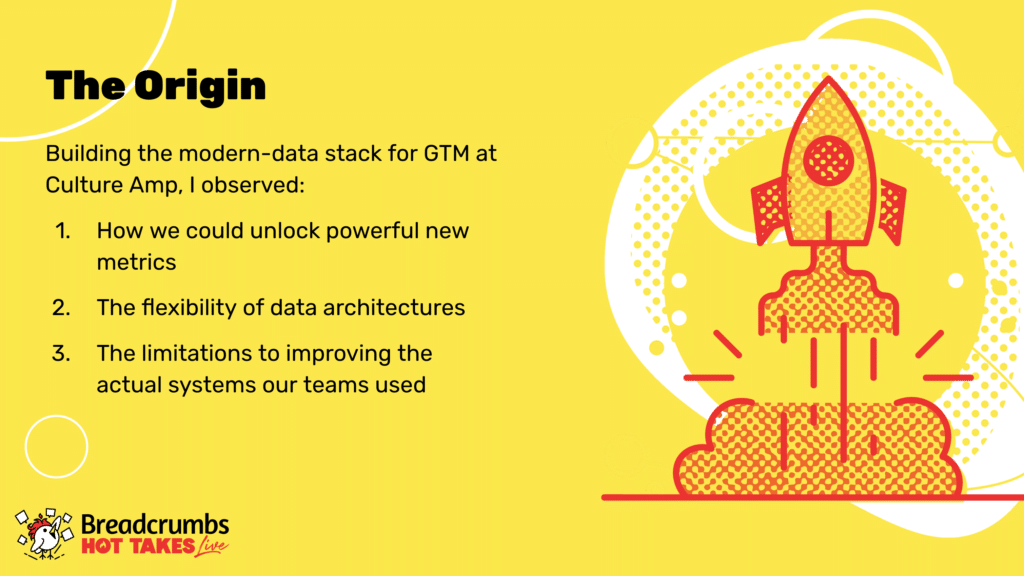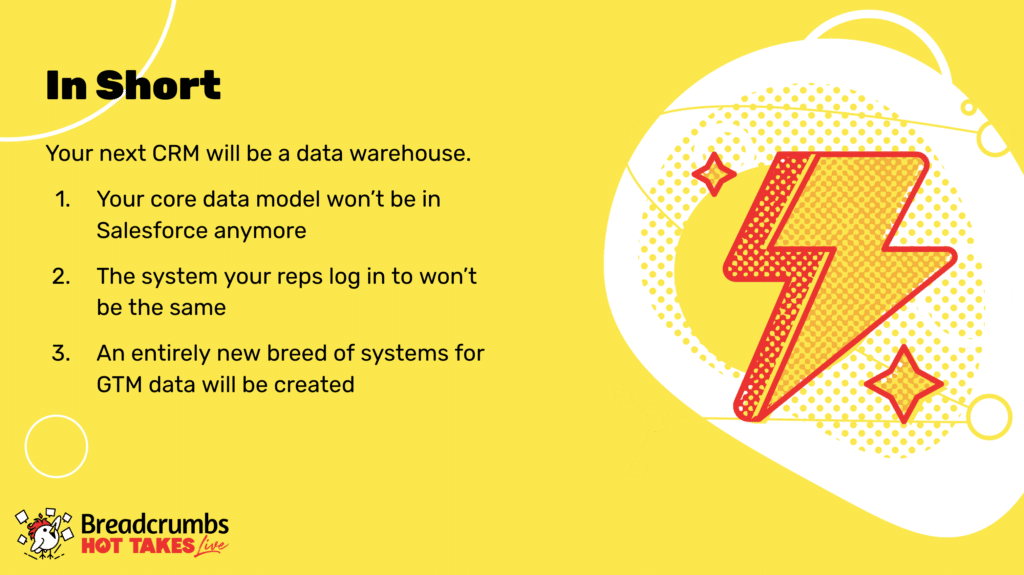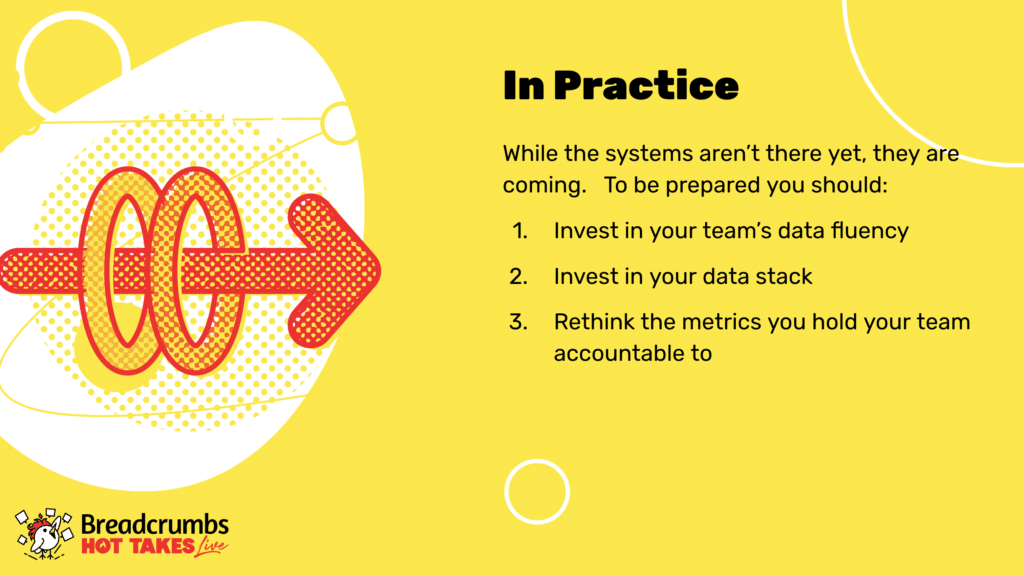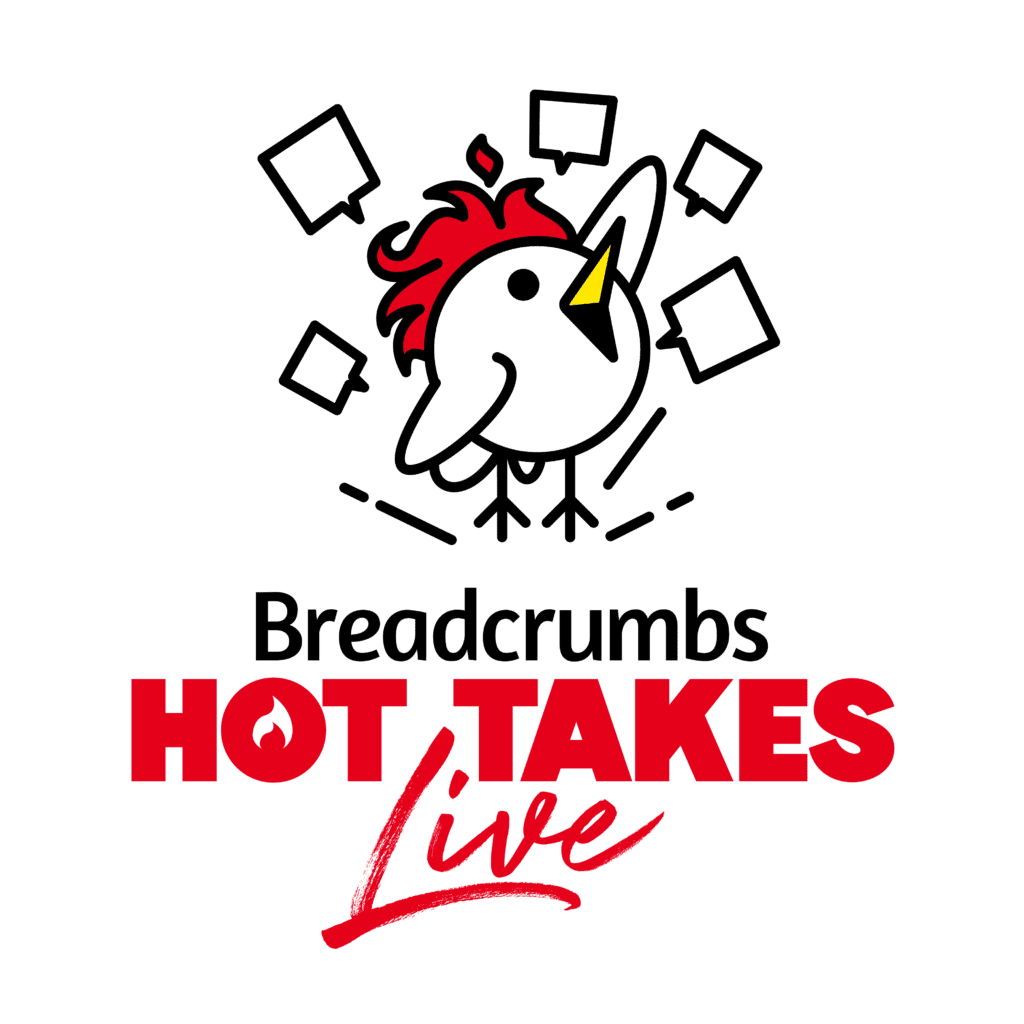Legacy CRM is a term you will start hearing more and more. Current CRMs are inflexible both in terms of their data models and UI for reps. The data warehouse has revolutionized how data is used, and moving to a more flexible CRM brings tons of advantages.
In this session with Andy Mowat, CEO at Gated, you will learn:
- How data is changing GTM
- The impact on how you manage your team
- The skill set changes will drive
[Transcript] Your Next CRM is a Data Warehouse with Andy Mowat
Although transcriptions are generally very accurate, just a friendly reminder that they could sometimes be incomplete or contain errors due to unclear audio or transcription inaccuracies.
Joe Aicher
Welcome to Hot Takes Live, the summer edition. You are joining us on our Ops stage, and so I’m super looking forward to all of our speakers today. My name is Joe Aicher; I’m the Director of RevOps Solutions here at Breadcrumbs.
So a lot of these topics I’m super excited for. If you guys have questions or comments as our speakers are talking, feel free to throw them into the comments section on the right of the platform, we can definitely bring those up and talk as we go.
I’m not going to waste any more time; I’m going to bring on our first presenter, his name is Andy Mowat; Andy, welcome to Hot Takes Live. How are you?
Andy Mowat
I’m good, Joe. Thanks so much; I appreciate the introduction.
Joe Aicher
Definitely super excited about your topic today, “Your next CRM is a data warehouse,” interested to hear what you have to say, so I’m going to step out of the screen and let you take over.
Andy Mowat
Absolutely. Thanks, Joe; I appreciate it. Great to see everybody. This topic is intended, at least the title, is intended to be a little bit controversial, but I do believe this is where the world is headed.
Just as a quick background, I’m currently running a company called Gated; we give people back control of their own attention. I’ve moved from running RevOps at three unicorns to doing Gated, but I always am advising investing and just talking to people about the state of RevOps and the state of data; it’s just been passionate for me for a long time.
I have had some fascinating backgrounds in terms of running a company in Prague and spending a lot of time over in Europe, but at this point in time, I am laser-focused, the last maybe 15 years, on scaling companies up.
So let’s get into it real quick. At Culture Amp, I got a chance to take a company from call it 5 million in revenue to about 100 million in revenue over the course of four years.

As part of that, we built out the modern data stack. Happy to talk more about that, I’m sure other people will, but I think there are terrific articles on that if you’re not familiar with what the modern data stack is, but as part of that process, I observed a couple of things.
One is there were just so many metrics that we couldn’t access out of Salesforce, out of HubSpot. One of my favorites is pipeline coverage. Normally, you can show up, and you can talk about what pipeline we have. Still, with pipeline coverage, you can start to talk about how that compares to other periods in time and how we ramp the pipeline, and you can create that right dialogue between marketing and sales.
Number two is the flexibility of data architectures. So there are lots of questions that you just can’t answer out of the legacy stack. A great example here was when we were selling our second product. We’d asked how long what’s the sales cycle for that and what’s the win rate and because the rep would add an SKU to a renewal opp, have a discussion, and remove it; you couldn’t see that a report on that in Salesforce because opportunities were real-time but the ability to kind of look back at the history of that and analyze it, was very powerful.
We also saw, just at a fundamental level, even after we had better data and better insights, running the exec and the decisions around go-to-market better with the modern data stack, it didn’t actually change the systems that our teams were using, so we didn’t make them much more productive.
We were just a lot smarter in what we did, and so that’s kind of the learning process that I went through at Culture Amp, so how is this informed, where I think the world’s going?

I fundamentally do believe that your next CRM will be a data warehouse. I don’t necessarily mean that your reps will log into that, and I’m happy to talk about that in more detail. I’ve written an article about that on my LinkedIn as well too.
I think what I saw is everybody is constrained by both the architecture of the go-to-market systems and they’re really constrained by the rep.
So if you think about it, when you put the core data model into Salesforce, it’s no longer in Salesforce, but it’s into a data warehouse, you can do a lot more things than I just described on the previous page.
Number two is the system your reps log into is not going to be Salesforce anymore. I think a great example there is ScratchPad. I’ve invested in ScratchPad. A lot of us that are running RevOps or sales teams have seen that your reps start using it. It’s more flexible; they can be a little bit quicker.
I had an entire team come to me and say, “Hey, we love this tool,” so I actually ended up investing in it, but that’s just the beginning of what you could do. Imagine if you can roll a UX for your team that’s not necessarily locked and loaded with your data model. It becomes a lot more flexible.
Then I think there’s this entirely new breed of systems for go-to-market data, for go-to-market Ops that will be created. A great example there, I would say, would be Sweep. They take your sales processes, you can design them visually, and then they can push them into your Salesforce, but they could also push them to other places like a data warehouse as well too.
So, if you believe this world is coming, what are some of the things you can do?

I’m assuming that different people have different levels of maturity on the data side, but one is just making sure that you’ve invested in your team’s data policy. I would say at Box, we had a course that anyone in the company could take, and it was called a 12-week course for SQL, and it brought everybody in the company along with us. We just had a much more data-fluent company.
Number two, I say invest in your data stack. There are lots of ways to do this; there’s kind of the full modern data stack, which is, frankly, a cold trip. It took us about a year to get there, but there are also tools that can help you get there with a little bit less complexity, things like Boost Up or Syncari.
Then, finally, rethink the metrics that you’re holding your team accountable to. We talked about a couple of those; pipeline coverage is one, and sales cycles on renewals is another one. Another one I’ve always loved, and that we use this at Box, because we also had a fairly sophisticated but complex data stack, was how many days before a churn or a contraction happens, did the CS rep identify it?
Sometimes churn itself is out of the CS reps’ control, but what’s not out of their control is identifying it and working it, and coordinating across the company. And so we started to hold people accountable to, are you identifying and working churn in the right way and risk of churn?
So this isn’t tomorrow, but it’s coming soon, which it’s less about configuring systems, it’s more about configuring data. I really am excited, as I think through both my investing, my advising, and the next steps of my career, to watch how this develops.
So at this point in time, I’m going to go ahead and turn over to Q&A, and Joe, feel free to pop back in whenever you want.

Hot Takes Live
Replays
Catch the replay of Hot Takes Live, where 30 of the top SaaS leaders across Marketing, Sales, and RevOps revealed some of their most unpopular opinions about their niche.
These leaders shared what lessons they learned and how they disrupted their industry by going against the grain (and achieved better results in the process).
Joe Aicher
Yeah, thanks, Andy. I’m not seeing any comments. Actually, no, we got one here, so let’s bring this up on the screen from Lisa. She asks what X pipeline coverage is best, or is it industry or company-focused?
Andy Mowat
Great question, definitely. First, I think there are some general industry standards you could think of. In broad terms, three to five times pipeline coverage. It’s going to vary dramatically by segment. If you’re in Enterprise, you’re going to need more if you’re in SMB, you’re less.
We even saw variations by region as well too, so hopefully that helps. Box and cold shrimp are very different businesses, but still, you could dial it in within a decent percentage.
Then also the beauty is you start to be able to look at what did we do last quarter, what do we do the prior quarter, and so you can start to understand if the pipeline coverage is going to be sufficient for our business.
Joe Aicher
Yeah, I think most businesses, at least from our perspective, managing a smaller sales team, that pipeline coverage is huge just as it’s just an initial goal for a lot of startups trying to get that pipeline coverage up to a certain amount just to make sure that you’ve got not only the next 30 days but the next six months covered.
Andy Mowat
I’m just going to add to that real quick. I think it’s fascinating to see the changes in meetings when you don’t just go from, “Do we have enough pipeline?” to “How is the pipeline evolving?” That’s what you couldn’t pull out with the classic Salesforce, but you know we were able to have conversations around, “Hey, it feels like pipeline coverage is a little bit low. Has the sales team cleaned it up?”
And you’d come back a week later, and you’d be able to see this drop in coverage or this pop-in coverage, or you’ll be able to see what happens. So you really start to understand much deeper what drives pipeline.
Joe Aicher
And you get to have much deeper conversations with your reps around priorities and how things are progressing. Then you get to map stuff back to those stage movements. It helps reinforce some of those metrics that you guys are looking at in terms of conversion through different stages as well; it makes everything more predictable, or at least gets to tweak that.
Great, one last question I had, maybe before we wrap up. You mentioned something from that reps’ perspective around maybe their interfacing or interacting with the data warehouse a bit more. I wanted you to clarify that statement a bit because you know the reps today are either in Salesforce or struggling with that in some capacity. You mentioned ScratchPad as maybe a good solution there.
But the data piece, it’s just super interesting to get everybody on the same page around those unified metrics and entering the right information at the right places. There are solutions you guys have had around that data warehouse of making sure that across all systems, things are being used in sync with each other.
Andy Mowat
I’d say, first off, I don’t think there are perfect solutions for a lot of this stuff, but I think it’s coming. To me, that your next CRM is your data warehouse is a very bold statement on purpose.
Because of just the update time and all of that, I don’t think the reps themselves will be logging into the data warehouse. There’s going to be an abstraction layer, but it doesn’t have to pump back into Salesforce; it can pump somewhere else.
I think, at a fundamental level, I look at it two ways. One is there are insights and dashboards that allow you to be intelligent. Those tend to be more like management executive level. And then there is like the rep UX, and the problem with that you’re seeing is, “Hey, I want reps to identify something on the opportunity and something on the contact and something on the account.” Well, all of a sudden, that becomes a mess.
And so I think what will end up happening really is, what you want to be able to do, optimize for every single rep role and even different regions, different ways and different segments, different ways, the right UX for reps that they can log in and do. And you want to be able to make as many of those decisions as possible for them of this goes here, this goes here, this is the minimum set.
One thing we did at Culture Amp is that we created a single button on the opportunity. You hit the button, and it says, “How can I help you?” and you’d say, “I need security review help, I need deal desk help,” and it would be it.
I think a lot of the job of Ops and teams is to be able to use data to make those rep rules to allow the reps to spend as much time as possible with prospects and customers.
Joe Aicher
Definitely, let’s get to Lisa’s comment here as well, “Any comments on methods to help accelerate pipeline movement, or is that another session?” frankly, I’m not sure if we have another session on that, Lisa, so maybe if you have a comment.
Andy Mowat
Drop me a note on LinkedIn, Lisa, I’m happy to help, but at a fundamental level, I would say community and the broader sense of community is really powerful. I’ve got an article on my LinkedIn about how we used community to accelerate and engage pipeline.
I think it’s not as the ability to kind of get on people’s mindset at Culture Amp, you know, we knew with eventually that people were going to want to be able to get that feedback from people, and our whole job was, “How do we just stay top of mind?” So events and community are some of my favorite ways to go.
Joe Aicher
Definitely all right, well. I think we’re good on comments right now, so Andy, I appreciate you jumping in for this session. For anybody interested in listening back, we’ll certainly have recordings for you later on.
Andy great talking to you today; best of luck.
Andy Mowat
Thanks, cheers.
